
The first printing was in London in September 1854 and sent to New Zealand with the plates. The stamps were issued on 18 July, 1855. All later printings were made in New Zealand.
The London printing
These were New Zealand's first postage stamps.
The 1d was a rich carmine shade, the 2d was blue with a greenish tint while the shilling was yellow green. The paper had a large star watermark and in both the 2d and 1/- was usually slightly blued due to an interaction between the ink and the paper.
The quantities sent to New Zealand were as follows:
- 50 sheets of the 1d (12,000 stamps)
- 275 sheets of the 2d (66,000 stamps)
- 33 1/3 sheets of the 1/- (8,000 stamps)
Copies of the London prints are rare and expensive. In the UK, the most readily available public view of copies is in the Tapling collection held in the British Library in London. An article on New Zealand items in the Library's collections is here. In New Zealand, the Rhodes Room in the Canterbury Museum contains what many regard as the finest collection of Chalon heads.
Printings in Auckland by Richardson
a) On blue paper
Although the original printing was made in London, all subsequent printings were made in New Zealand. In November 1855, Mr J Richardson was awarded the contract to print the stamps. According to the records he was the "one person in the town (Auckland) competent to print postage stamps".
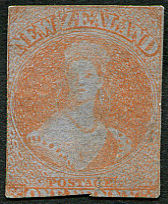
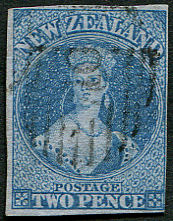
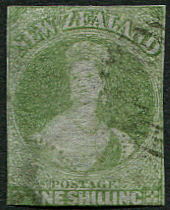
The star watermark paper had been sent from London with the plates, but Richardson felt that its quality was unsatisfactory. Hence, between 1855 and 1857, he used an unwatermarked blue paper.
Richardson printed 29,016 copies of the 1d in
November and December 1855
while the 2d and 1/- values were not produced until 1856.
The number printed is unknown due to the records having been lost.
b) On thick white paper
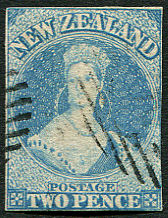

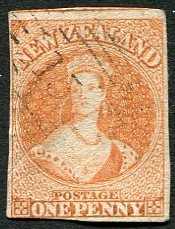
In 1858, Richardson changed to a white paper which again had no watermark. Most of the paper was very thick and soft, but stamps were also printed on a harder and less thick paper.
The 1d was printed in shades ranging from dull orange to
orange-vermilion while the 2d was printed first in pale blue
and then in ever deeper shades of blue.
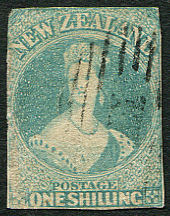
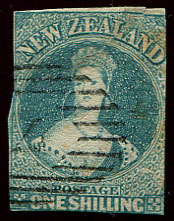
Two shades of the 1s are listed in catalogues, pale emerald green and greenish blue. However, this is misleading.
The pale emerald green group describes stamps that are pale and rather washed
out and range from pale green to pale blue green.
The greenish blue stamps are much brighter and are closer to the colour of the 2d
than to the usual colour of the shilling.
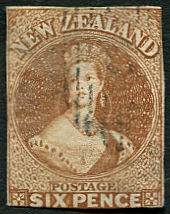
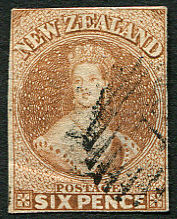
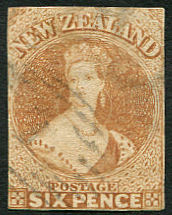
In March 1857, the postage rate on half ounce letters to the United Kingdom was reduced to 6d, but it was not until August 8, 1859 that a 6d value was issued in brown.
The plate was again made by Perkins, Bacon in London. Shades include bistre brown, chestnut and deep to pale brown.
The Richardson prints are all of a very high standard with the fine mesh of the background being clearly seen. However in 1861, it was decided that, instead of the printing being contracted out, a person should be employed full time to carry out the printing.
John Davies became the Government Stamp Printer in February 1862
and continued in that post until he died in December 1889.
c) Roulettes
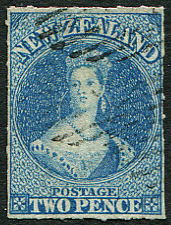
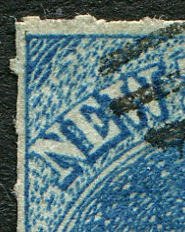
There were various experiments in separating the stamps using roulettes and serrates. The commonest is a roulette gauging 7 shown in the figure, but all are fairly rare, some extremely so.
Forgeries are a danger with the experimental separations.
As the illustrated stamp has not been submitted to any of the Expert Committees,
the roulette may not be genuine.
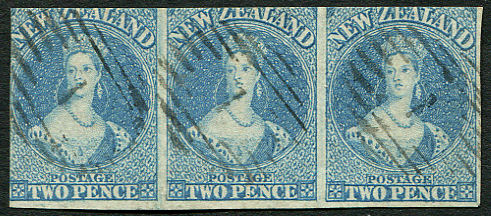
A problem with the roulettes and with the later perforations is that the original plates were laid down with a very small gap between the stamps as can be seen in the following strip. As there were also considerable irregularities in the positioning of the images on the plate, many issued stamps are off-centre.
Until April 1862, postage could be
prepaid in cash rather than
by the use of postage stamps.
The above information is taken from The Postage Stamps of New Zealand Vol 1, published by the Royal Philatelic Society of New Zealand in 1938. All scans were made by the author.